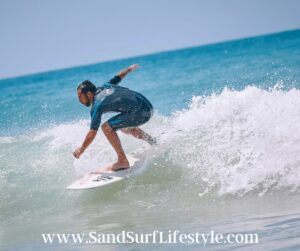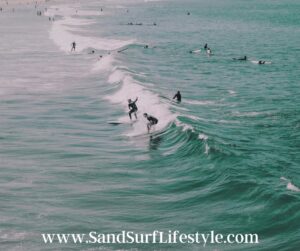You’re in the water. You’re surfing. You should be far more excited about this, and having way more fun. However, you’re not because you keep slipping, stumbling, missing waves, and just generally wiping out. You’re returning home bruised up, exhausted, and not feeling very rewarded by your time in the water. Even looking at your board is beginning to bum you out. Should you just quit surfing altogether? No, of course not! Even the professionals started somewhere. If you ask them what they did to get to the top, you’ll probably be surprised to learn how much failure and training it took for them before they even started to get it right. Not only did they run a variety of drills with a focus on repetition, consistency, intensity, and standard self-care, but they never stopped — not even once they made it to the big leagues.
Stretch and Warm-Up Before Getting in the Water:
It’s extremely important to stretch even before surfing. While this probably sounds obvious, this is a step a lot of surfers skip in their eagerness to get into the water. Nevertheless, stretching not only helps to prevent unnecessary injury but also makes you more flexible and better able to navigate your board and body in the water.
Take your time stretching at the shore before getting in. There’s no rush — the water isn’t going anywhere. Observe the water, the weather, and other surfers who are already out there. Watch what they do — in general, just to improve your skills, and also to see if there is anything special they are doing to adjust to the waves or the specific conditions that day. Watching a sport carefully with the intent to learn can be nearly as powerful as practicing it firsthand. Paired, these will make you a very strong surfer.
It’s also valuable to remember that the water will always be cold. Lower temperatures negatively impact your body’s elasticity and affect blood flow, therefore making you more prone to injury and burnout. That’s why, in addition to basic stretching alone, pairing it with some light cardio such as jumping jacks, jump roping, or jogging in place is also a good call. Just don’t exhaust yourself before even getting into the water!
Practice Paddling and Build Arm Strength:
This probably also sounds pretty basic, but being able to paddle well is a critical part of surfing. Still, because it’s relatively dull, it’s a detail a lot of surfers glaze over in their training.
Moreover, if you’re not in shape or not used to it, padding can be especially difficult — therefore already leaving you feeling depleted before you even begin to catch any waves. You may feel silly doing it, but spend part of your surf session in shallow or medium waters, paddling without hopping up on the board or catching any waves. This may feel tedious, boring, or ridiculous at first, but you’ll be glad you practiced this skill so thoroughly. You’ll also have an edge once this aspect of surfing no longer fazes or otherwise exhausts you.
Push-ups, arm circles, planks, and other dry, standard arm exercises make up another important part of training. For surfers, push-ups come as the most highly recommended and should be prioritized above other arm workouts. This is because they require the participation of your entire body, assist with alignment, and simultaneously build your shoulder and core muscles — both of which are vital for any surfer. Push-ups also greatly improve your abilities to pull off strong pop-ups and duck dives — defining moves all surfers need to practice, polished, and in their arsenal of basic skills.
Note that these standard arm exercises are not replacements for practicing your paddling in the water. Even though they do help build strength, paddling requires a unique set of muscles that demand separate training in the water itself.
Have a ding in your surfboard? Learn how to fix it here.
Incorporate a Variety of Squats:

Several times a week, surfers — especially beginning ones — should spend adequate time doing a rotation of squats. This includes basic, jump, single-leg, Bulgarian split, barbell, and braced squats. Each of these works important muscles and will improve your ability both in the water and on your board. A strong lower body equals a strong, sturdy base — and as you probably already know, this is the kind of thing that can either make or break you while surfing.
Just like with any other exercise mentioned in this article, how many repetitions you do or how much time you contribute to these workouts depends entirely on you. Surfers come at different levels of fitness and endurance, and therefore, it’s important to create a routine that works well for you. You can always increase the intensity later on.
Either way, be sure not to cheat yourself by doing the bare minimum. Push yourself and push your body as much as you reasonably can without overworking or injuring your muscles, joints, nerves, or ligaments.
Work your Hips with Lunges:
Yes — surfers are advised to do lunges, too. You might be asking why you need to do lunges in addition to squats. Both work the lower body, right? Right.
Nonetheless, they serve separate purposes for surfers. Squats build required strength and help you to establish a strong, sturdy base with your lower body. Lunges, however, also work and strengthen your hip joints. For surfers, this is vital for shifting in the water, and body movement in general.
Lunges also majorly improve balance and alignment. Both are major game-changers when it comes to surfing, and shouldn’t be overlooked — despite how dull they may seem.
Develop Core Strength:
There are very few sports that don’t require a strong core for maximum performance. Moreover, your core is the center of your body, and therefore determines stability, movement, and direction just as much as, if not more than, any other body part. Regardless of whether you realize it, surfing does activate your core. More importantly, it requires it.
Planks, although mentioned previously, come highly recommended enough for surfers and serve so many vital functions that they’re worth mentioning again. Additionally, standard, reverse, bird dog, and bicycle crunches are all great exercises for surfers to incorporate. The glute bridge should also not be overlooked — especially since it majorly works the lower body in addition to the core alone.
Further, Establish Balance and Stability with a Medicine Ball:
Training with a medicine ball isn’t just about strength — at least not for surfers. By doing a water sport, especially one where you are relying on nothing but your body, your board, and the [unpredictable] waves to keep you safe, moving, and alive, familiarity with functioning efficiently in unstable conditions is critical. While this may seem redundant after the other listed exercises, as working with a medicine ball also increases arm, core, hip, and general lower body power, this is different. Not only does it further sharpen balance and endurance [in addition to building even more strength], but it also ensures you can handle your body in a variety of volatile conditions.
 Russian twists, rolling push-ups, triceps extensions, jackknives, dumbbell rotations, dumbbell row, and ball presses are some of the best exercises surfers can utilize on the medicine ball.
Russian twists, rolling push-ups, triceps extensions, jackknives, dumbbell rotations, dumbbell row, and ball presses are some of the best exercises surfers can utilize on the medicine ball.
Practice Getting and Standing on your Board in the Water:
Paddle out on your board to water depths you believe are safe for you regarding any possible wipeouts, but still, find provide you with a light challenge. Calm waters will do here, but light turbulence also doesn’t hurt once you have spent sufficient time surfing.
Obviously, you can’t surf without first getting on your board. However, clumsy, slippery, and half-hearted mounts can seriously sabotage your attempts. They can exhaust you, discourage you, and even cause you to flip out your board or hurt yourself. That’s why you don’t want to be practicing them solely when you’re about to catch a wave. Rather, you should spend some time practicing your mounts all by yourself without the intention of actively surfing immediately. Repeat these drills until they become second nature.
Use some of these just to practice standing on your board as well. Once you’re upright, take some time to get into position, balance yourself, and establish a sturdy base. Use your core, and even lift through it a bit. Learn how to be light on your board and the water without entirely losing your weight on either.
Now, maintain that position for a while. Get a feel for how it feels to stand on your board in the water comfortably and for an extended period of time. Eventually, you’ll find that this is no longer strenuous work. The transition from mounting to getting into position should also become so smooth that you could do it in your sleep.
This is also a good place from which to practice shifting your hips and dismounting. Although far less glamorous, these are also crucial skills to master for any serious surfer.
Learn How to Bend Your Knees:
The ability to bend your knees quickly and with ease is important in many sports, and surfing is no exception. Being able to bend your knees comfortably can either make or break you as a surfer. While you may feel silly about it, constantly practice bending your knees. Boxers and dancers do it, and surfers should, too.
This is a simple habit you can incorporate both in and out of the water. On land, get in position and bend your knees. Repeat bending them and unbending them slightly. Don’t let them lock.
After a while, try bending your knees and holding the position for a while. Even try doing this for a minute or two before getting in the water, just to loosen up your knees and get some blood flowing through them so that you can move them more easily later on while surfing.
Once you’re in the water, stand on your board, get in your respective surfing stance, establish your balance, and practice bending and unbending your knees. Again, even if you feel silly doing this, don’t worry about what anyone else thinks. You’re developing a skill and comfort with it that will make you a far better surfer. Eventually, you’ll be glad you toughed it out and did it.
And remember — the squats you’re already doing should help with this, meaning that these knee-bending drills should get less exhausting with time.
Take Care of Your Body:
 Eating well and getting enough rest is just as important as any athletic skills you may develop in or out of the water. Healthy, nutrient-rich foods eaten in sufficient proportions will help keep your body energized and primed for surfing. Prioritize nutrition. Get your vitamins, include tons of protein in your diet, and eat enough carbs without overloading.
Eating well and getting enough rest is just as important as any athletic skills you may develop in or out of the water. Healthy, nutrient-rich foods eaten in sufficient proportions will help keep your body energized and primed for surfing. Prioritize nutrition. Get your vitamins, include tons of protein in your diet, and eat enough carbs without overloading.
Icing sore muscles and implicating the occasional sports massage into your routine, if possible, can also play major roles in your body’s ability to hold up well as a surfer. Epsom salt baths are also come highly recommended by many professional athletes.
Additionally, while it might not sound especially invigorating, rest days and getting tons of sleep are both critical for any athlete — especially those doing extreme sports like surfing. This allows your body to relax, helps to prevent injuries through overexertion, enables you to recover from training, and lets you better build your strength, flexibility, and endurance.
Doing small things like taking a hot shower around bedtime, drinking a glass of warm milk or chamomile tea before falling asleep, and investing in comfortable linens and sleepwear can all majorly contribute to your general quality of sleep.
Immerse Yourself in Surfing:
A popular and proven training philosophy is that of immersion. One terrific example of this is obtaining fluency in a foreign language by submerging yourself in an environment where this is the only one spoken, and doing so for extended periods — days, weeks, or even months and years. This is more efficient than spending a few hours in a classroom or pouring over textbooks for a little while each day, only to then return to your usual life.
Sacrificing consistency is a harsh consequence of the demands of everyday life, but there are loopholes people can utilize accordingly. This also applies to sports — including surfing. If possible, take a surf trip, even just for a few days. A surf town where surfing is prioritized and the general lifestyle is centered around it is preferable. Dedicate the entire time to surfing, training drills, speaking to other, more experienced surfers, and resting as needed.
You’ll come out of it a much better and happier surfer.
Please note: This blog post is for educational purposes only and does not constitute legal or medical advice. Please consult a legal expert or medical professional to address your specific needs.

